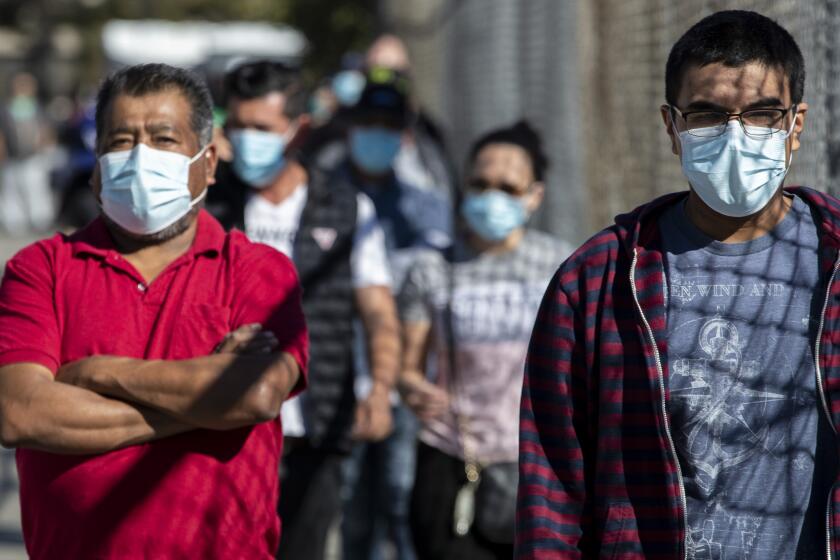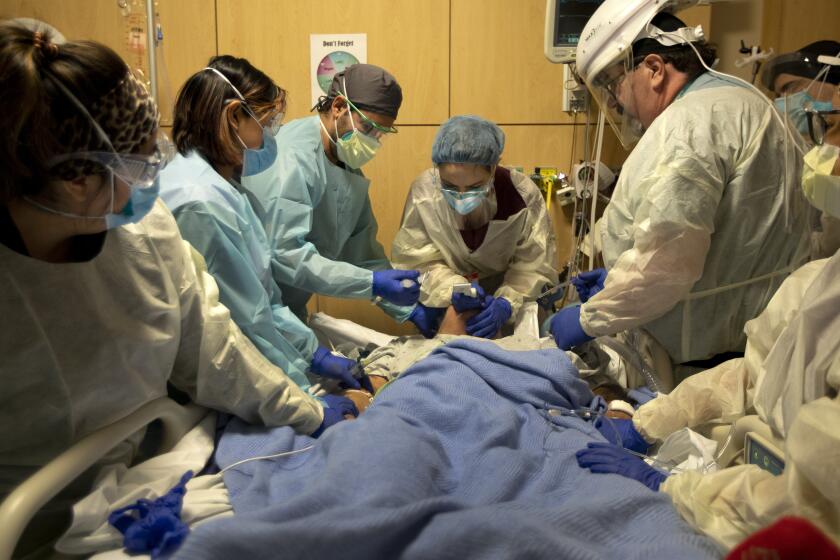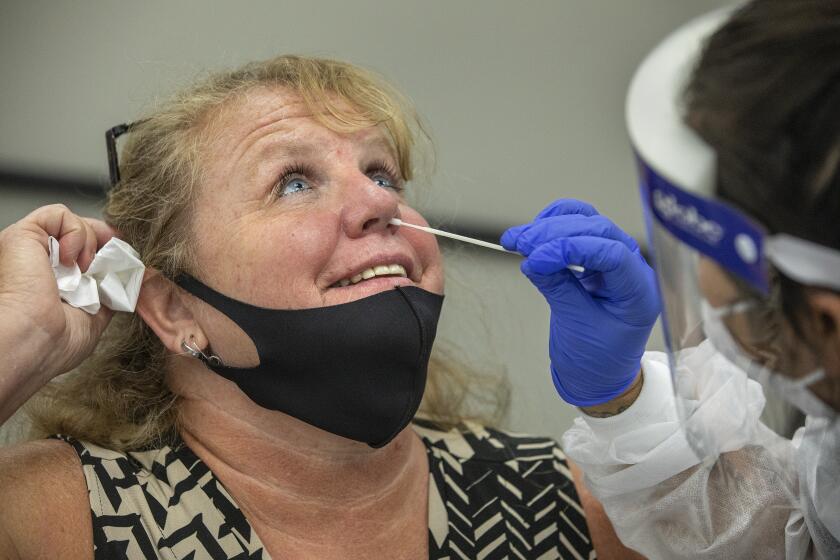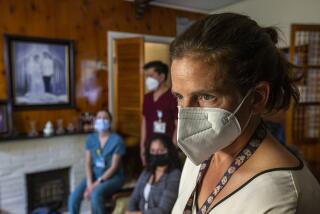Orange County healthcare system is ‘in crisis’ as COVID-19 hospitalizations hit record
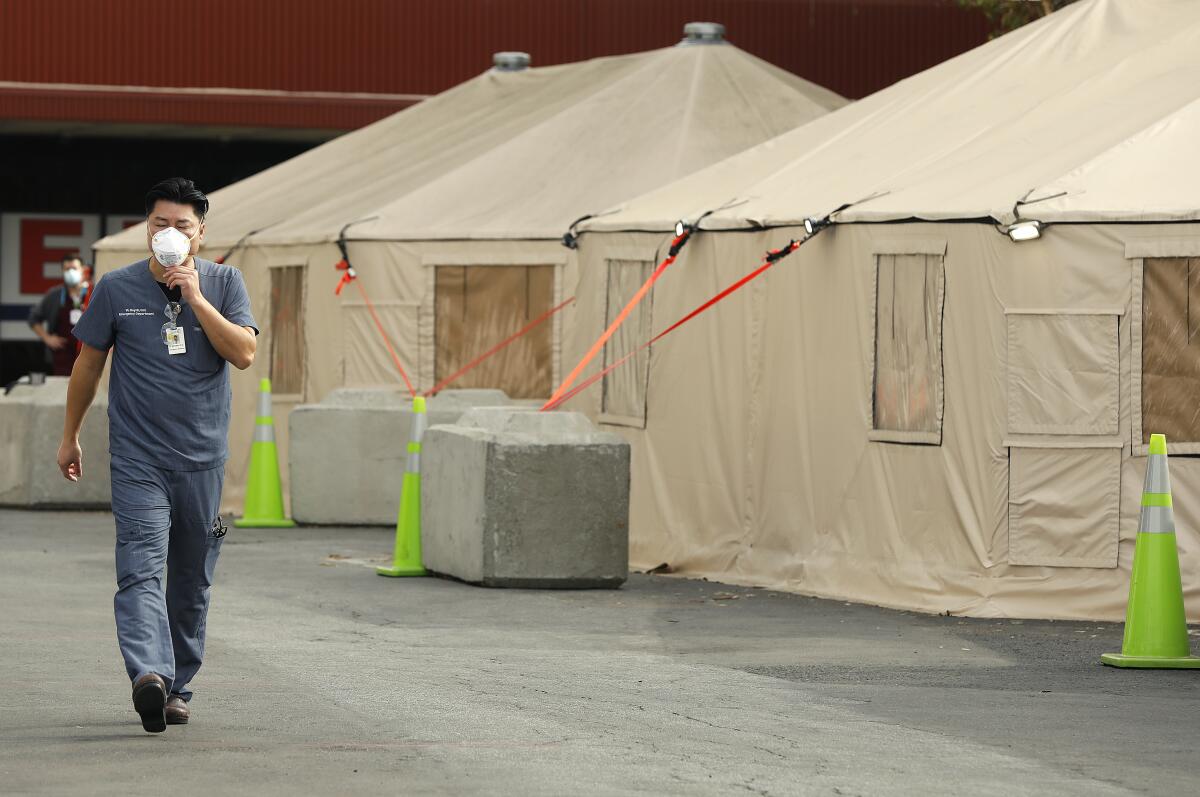
The number of coronavirus-positive patients flooding Orange County hospitals has hit crisis levels, prompting one official to warn that the region’s emergency medical system could be at risk of collapse unless steps are taken to alleviate the stress.
Orange County, like much of California and the nation as a whole, has been inundated with an unprecedented influx of COVID-19 patients, which has resulted in some ambulances having to wait hours to offload their patients, according to Dr. Carl Schultz, emergency medical services director for the county Health Care Agency.
The county’s healthcare system “is now in crisis resulting from an overwhelming increase in the number of COVID infected patients,” he wrote in a memo Wednesday to hospitals and ambulance and paramedic providers.
As of Thursday, there were 1,122 coronavirus-positive patients hospitalized countywide — an all-time high and more than double the number from two weeks ago. Of those, 265 people were in intensive care, according to the latest available data.
“At the current rate of deterioration, the EMS system may collapse unless emergency directives are implemented now,” Schultz wrote.
Some immediate steps, he said, include allowing ambulances to travel longer distances to take patients to hospitals that can accept them, and permitting them to take a patient to another hospital if they’ve been waiting outside with the patient for more than an hour.
COVID-19 spikes spill into dozens of L.A. County communities in the San Gabriel Valley, South Bay, the Westside and central L.A.
Hospitals also should consider activating their surge plans, establishing alternate treatment areas and canceling elective surgeries, he added.
“While it is clear no one is to blame for this crisis, all can participate in mitigating its effects,” he wrote.
Dr. Clayton Chau, Orange County’s health officer and Health Care Agency director, also encouraged residents “who can get services through urgent care, can get services through their primary care physician [to] please go ahead and do so, and not just show up to the emergency room.”
During a briefing Thursday, Chau said that Schultz’s letter “is just to be cautious and make sure that we have a plan with all of our hospitals and not wait until the last minute.”
That planning has become all the more vital as the county — along with the rest of the state — is in the throes of the worst wave of the coronavirus pandemic.
Californians are testing positive for and falling ill and dying from COVID-19 at unprecedented levels. The state has averaged nearly 29,000 new coronavirus cases a day and about 150 daily deaths over the last week.
The timing and acceleration of the surge indicates that many ignored officials and experts’ calls to eschew traveling and gathering for Thanksgiving — a potentially chilling prospect, given the wider winter holiday season is in full swing.
“Those of you who dread holidays, getting together with family, this is the season when you have a good excuse not to do so,” Chau said. “Please do not mix. Do not travel. You need to stay put, and if you’re sick, you need to stay home.”
An all-time high of 12,013 coronavirus-positive patients were hospitalized statewide as of Thursday. A record 2,669 Californians were in intensive care.
Along with Orange, two other California counties had more than 1,000 coronavirus-positive patients in their hospitals as of Thursday: San Bernardino, with 1,132, and Los Angeles, with 3,850.
The number of people hospitalized in L.A. County with coronavirus infections has doubled since Thanksgiving and quadrupled in the last month. The county has also shattered its daily record for new coronavirus cases in each of the last two days, reporting a staggering 13,815 on Friday.
“Like a speeding car approaching a cliff, if we do not rapidly change course, we are in jeopardy of catastrophic consequences,” Dr. Paul Simon, chief science officer for that county’s Department of Public Health, said during a briefing Thursday.
As of Thursday, there were 3,850 hospitalized COVID-19 patients in L.A. County, including 856 in ICU beds — both records.
Officials have long warned that skyrocketing coronavirus infections will invariably trigger a flood of people sick enough to require hospitalization, usually two to three weeks down the line.
This means hospitals have likely yet to see the fallout from this week’s sky-high case counts — an alarming possibility, given that resources, capacity and staffing are all already stretched thin.
Of particular concern are ICU beds, which require high-tech equipment and specially trained professionals to care for the sickest patients.
In a bid to shield that system, California is implementing new stay-at-home orders when ICU capacity drops below 15% in any one of five state-defined regions.
Such orders — which reduce customer limits at retail stores; close businesses including hair and nail salons, card rooms, museums, zoos and aquariums; and prohibit outdoor restaurant dining — are already in place in three regions: Southern California, the San Joaquin Valley and Greater Sacramento.
The state’s two other regions, the Bay Area and rural Northern California, remain above the 15% threshold for now
Massive, regular coronavirus testing could help K-12 schools reopen and stay open, but so far California has been unwilling to recommend it or pay for it.
Because of the current trends, some Bay Area counties — including San Francisco, Santa Clara, Contra Costa, Alameda and Marin — have elected to preemptively adopt the additional state restrictions.
Sonoma County will add its name to that group effective at 12:01 a.m. Saturday, officials announced.
Though that county “has fared better until now than other parts of the state in terms of demand on our hospitals, we have been seeing an alarming increase in cases and hospitalizations in recent days, and this is putting increased strain on our medical resources,” health officer Dr. Sundari Mase said in a statement.
“We have to take action now,” Mase added.
The state’s latest approach has not been without controversy, though. Some have characterized the additional restrictions as overly broad and unscientific, saying they won’t provide enough of a public health benefit to justify the pain they will cause the state’s already battered economy.
Others have taken issue with the makeup of the five regions, or the state taking a regional view at all. The Southern California region — a sprawling swath encompassing Imperial, Inyo, Los Angeles, Mono, Orange, Riverside, San Bernardino, San Diego, San Luis Obispo, Santa Barbara and Ventura counties — has drawn particular ire, as critics say it’s far too large and lumps together too many disparate communities.
Michelle Steel, a Republican congresswoman-elect and current chairwoman of the Orange County Board of Supervisors, said Thursday that “everyone understands the seriousness of this virus and what we must do, but a one-size-fits-all approach is simply not right.”
The “top-down” mandates from the state throughout the pandemic, she said, have “been an inconsistent mess, moving the bar and creating new criteria each time to justify their actions with no scientific base.”
“These moves haven’t stopped the spread of the virus, but have severely harmed families’ ability to make a living, crippled business owners and forced too many to the unemployment lines,” she said.
More to Read
Sign up for Essential California
The most important California stories and recommendations in your inbox every morning.
You may occasionally receive promotional content from the Los Angeles Times.
